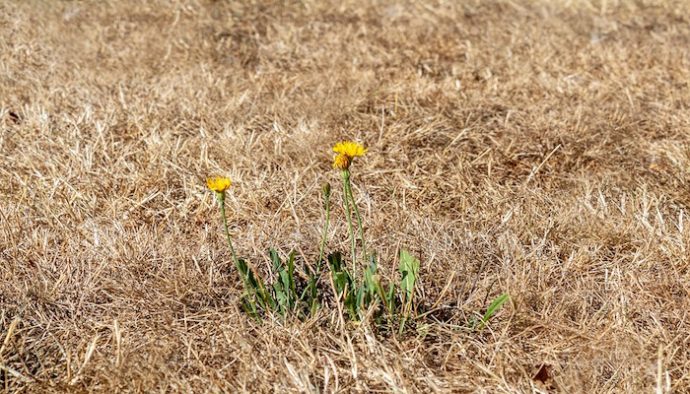I’m a lawn guy. There are very few things that give me more satisfaction than a well tended, taken care of, neatly trimmed, lush, green lawn. And here in middle Tennessee we are fortunate because we have the kind of climate that allows for lawns like this. For many, a lawn like that doesn’t even require putting a sprinkler on it. Not everyone is as lucky as me with the climate I live in, and have to check out sprinkler reviews at lawngardentop.com to make sure their grass is in good condition. That’s not to say lawns around here don’t get weeds; they do. And it’s not to say that lawns don’t get brown; they do. What’s curious, though, is that a lawn can brown even when it’s been raining.
It’s counterintuitive, isn’t it? It certainly is for me because I tend to think that the most important ingredient to a green lawn is water. A brown lawn seems to indicate dryness. But sometimes a brown lawn doesn’t mean there’s been too little rain; it means there’s been too much. Of course, you could always look into a company that provides california lawn care if you want expert advice on keeping a lawn green. I can sit around and ponder it, but not everyone has time to worry over the correct amount of water a lawn needs…
For a lawn to be healthy, it needs to have roots that go deep. And when it rains all the time, there’s no reason for the roots to go deeper to find water. All that water is right there, right below the surface. This is why in case a week goes by without any rain, one of two things can happen. The first one is that the soil in the lawn can get loose, and possibly erode. That can be prevented by simply getting a retaining wall constructed around your lawn. Prevention of eroding soil, and the providing of structural support to the lawn are two important concrete retaining wall benefits, especially if you live on land that is not flat.
The other problem that can be encountered in the event of a dry week with no rain, is the drying up of the beautiful grass that looked healthy and fresh less than a week ago.
Curious, right?
Curious, and instructive. Because there’s probably a principle here from nature for us to learn from.
Rain, we tend to think, is about life. It’s about growth. It’s about prosperity. It’s about plenty. And most of us live in a state of rain, for we indeed have plenty. And perhaps that is part of the problem. At the first sign of adversity, we might tend to throw our hands up in frustration, gaze at the sky longingly, and wonder whether our faith has been misplaced. When we stop feeling wet, there is a panic moment. In terms of the illustration above, we tend to turn brown. And as we do, we look to the circumstances around us as the problem.
But maybe the problem is not that there’s not enough rain; maybe the problem is that there’s too much. With all this rain in our lives, we have had no reason to send deep the roots. Consider, for a moment, the often misunderstood words of Paul in Philippians 4:
“I have learned to be content in whatever circumstances I am. I know both how to have a little, and I know how to have a lot. In any and all circumstances I have learned the secret of being content-whether well fed or hungry, whether in abundance or in need. I am able to do all things through Him who strengthens me” (Philippians 4:11-13).
We tend to isolate verse 13 and use it as a catch-all verse for victory and success:
- I can make an “A” on this test through Christ who strengthens me.
- I can nail this presentation through Christ who strengthens me.
- I can cut a great deal through Christ who strengthens me.
Paul wasn’t giving some secret key to earthly success; he was writing specifically about contentment. And this is important for all of us because every single person in Christ will know the experiences he outlined in these verses. We will all have more and less at different points in our lives; we will all be both in abundance and in need. There will be days that feel very wet, and days that seem very dry. The seasons of life will change; they will ebb and flow; and yet according to Paul, through Christ we can maintain a stable source of joy and contentment through Christ and Christ alone.
Now you might look at this passage and feel a sense of discouragement. It’s not particularly uplifting to recognize the reality that at some point, circumstances will change. You, like me, will experience points of loss and need and sadness in this life. The encouraging part of this verse isn’t that we aren’t going to feel the pain of those things. No – the encouraging part of this verse is that Paul learned the secret of being content.
In other words, contentment isn’t our natural state, but it can be learned. We can develop a certain aptitude for contentment. And the school in which we learn contentment is the school of loss. When we feel the sense of despair and when we feel the temptation of accumulation, we can remember that we are sitting in the classroom of life. And through these lessons, we will learn how to trust in Jesus for our self-worth, our joy, and our comfort. And slowly but surely, we will find ourselves progressing in this school.
It’s through these seasons of dryness that the roots of our faith are trained to go deep. And in this, at least, it means that the dry times are cause for a measure of rejoicing, for we know as James put it, that we can “consider it a great joy, my brothers and sisters, whenever you experience various trials, because you know that the testing of your faith produces endurance. And let endurance have its full effect, so that you may be mature and complete, lacking nothing” (James 1:2-4).
Our faith is not crushed through these dry spells; instead, it’s through these dry spells that our roots learn to go deeper. Be encouraged today, Christian, if the lawn of your life is looking a little brown, for it’s in these moments that we learn. We learn to go deep.
Subscribe to MichaelKelley.co
Never miss a new post. Subscribe to receive these posts in your inbox and to receive information about new discipleship resources.





2 Comments